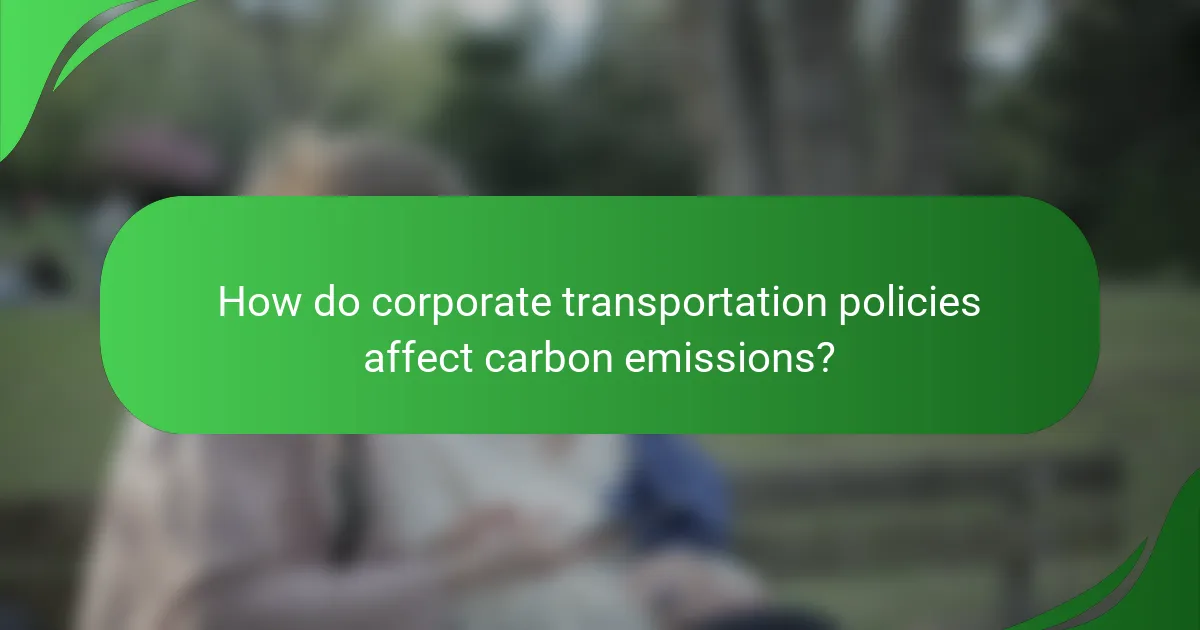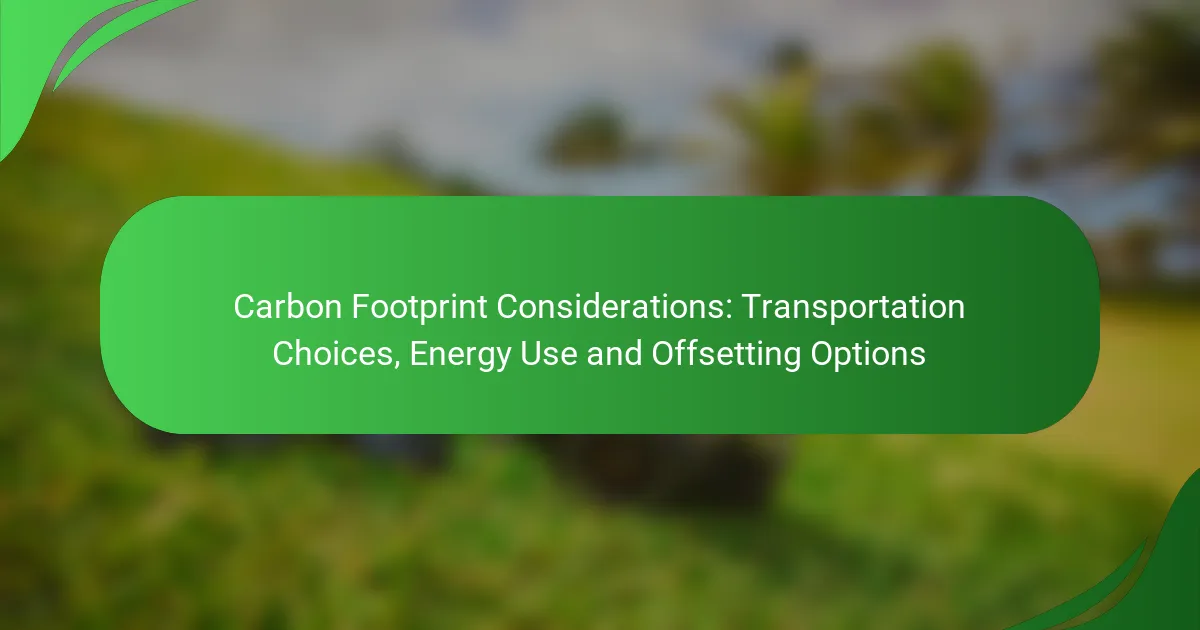Understanding the impact of transportation choices, energy use, and carbon offsetting options is crucial for reducing one’s carbon footprint. By selecting sustainable transport methods and adopting energy-efficient practices, individuals can significantly lower their greenhouse gas emissions. Additionally, engaging in carbon offset initiatives allows for meaningful contributions to environmental preservation, helping to balance out unavoidable emissions.

How do transportation choices impact carbon footprint?
Transportation choices significantly influence an individual’s carbon footprint, as different modes of transport emit varying levels of greenhouse gases. Opting for more sustainable options can greatly reduce overall emissions and contribute to environmental preservation.
Public transportation benefits
Public transportation, such as buses and trains, typically produces lower emissions per passenger compared to private vehicles. By utilizing these systems, individuals can help reduce traffic congestion and decrease air pollution.
In urban areas, public transit can lower carbon footprints by up to 45% per passenger mile compared to single-occupancy vehicles. Additionally, many cities are investing in cleaner technologies, making public transport even more eco-friendly.
Electric vehicle advantages
Electric vehicles (EVs) offer a cleaner alternative to traditional gasoline-powered cars, producing zero tailpipe emissions. While the carbon footprint of EVs can vary based on electricity sources, they generally contribute to lower overall emissions when charged with renewable energy.
Many countries provide incentives for EV purchases, such as tax credits or rebates, which can offset initial costs. Additionally, as charging infrastructure expands, the convenience of using EVs continues to improve.
Carpooling effectiveness
Carpooling effectively reduces the number of vehicles on the road, which can lead to lower emissions per person. By sharing rides, individuals can significantly decrease their carbon footprints while also saving on fuel costs.
Organizing carpools can be simple with apps and platforms designed to connect commuters. Even occasional carpooling can lead to substantial reductions in greenhouse gas emissions over time.
Walking and biking options
Walking and biking are the most sustainable transportation choices, producing no emissions. These options not only reduce carbon footprints but also promote physical health and well-being.
In many cities, infrastructure improvements, such as bike lanes and pedestrian pathways, make these options safer and more accessible. Committing to short trips by walking or biking can lead to significant environmental benefits and a healthier lifestyle.

What energy use practices reduce carbon emissions?
To reduce carbon emissions, adopting energy-efficient practices is essential. This includes using appliances that consume less energy, switching to renewable energy sources, and integrating smart home technology to optimize energy usage.
Energy-efficient appliances
Energy-efficient appliances are designed to use less electricity or gas while providing the same level of performance. Look for products with ENERGY STAR ratings, which indicate compliance with energy efficiency guidelines set by the U.S. Environmental Protection Agency or similar organizations in other countries.
Common examples include LED light bulbs, high-efficiency washing machines, and refrigerators that consume significantly less energy than older models. Upgrading to these appliances can lead to savings on utility bills and a reduction in overall carbon footprint.
Renewable energy sources
Switching to renewable energy sources, such as solar, wind, or hydroelectric power, can drastically lower carbon emissions associated with energy use. Many households can install solar panels, which harness sunlight to generate electricity, often resulting in lower energy costs over time.
In some regions, utility companies offer green energy programs that allow consumers to purchase energy generated from renewable sources. This not only supports sustainable practices but also contributes to a cleaner energy grid.
Smart home technology
Smart home technology can enhance energy efficiency by automating and optimizing energy use in your home. Devices such as smart thermostats, smart plugs, and energy monitoring systems allow homeowners to track and control their energy consumption more effectively.
For instance, a smart thermostat can learn your schedule and adjust heating and cooling accordingly, potentially reducing energy use by 10-15%. Integrating these technologies can lead to significant reductions in carbon emissions while providing convenience and cost savings.

What are effective carbon offsetting options?
Effective carbon offsetting options include initiatives that help reduce greenhouse gas emissions, such as tree planting, purchasing renewable energy credits, and participating in carbon offset programs. These methods allow individuals and businesses to compensate for their carbon footprint by supporting projects that either absorb carbon dioxide or prevent emissions.
Tree planting initiatives
Tree planting initiatives involve the cultivation of trees to absorb carbon dioxide from the atmosphere. These programs can vary widely in scale, from local community projects to large-scale reforestation efforts. Participating in such initiatives can be a direct way to contribute to environmental restoration while offsetting personal or organizational carbon emissions.
When considering tree planting, look for certified programs that ensure the trees are planted in appropriate locations and maintained over time. Some initiatives may offer the option to track the growth and carbon absorption of the trees you help plant.
Renewable energy credits
Renewable energy credits (RECs) represent proof that energy has been generated from renewable sources, such as wind or solar. By purchasing RECs, individuals and businesses can offset their carbon emissions by supporting the production of clean energy. Each REC typically corresponds to one megawatt-hour of renewable energy generated.
When buying RECs, ensure they are certified by recognized standards to guarantee their authenticity. This option is particularly beneficial for those who cannot install renewable energy systems on their property but still wish to support the transition to cleaner energy sources.
Carbon offset programs
Carbon offset programs allow individuals and companies to invest in projects that reduce or capture greenhouse gas emissions, such as methane capture from landfills or renewable energy projects. These programs often provide a way to calculate your carbon footprint and suggest specific offsets to purchase based on your emissions.
When selecting a carbon offset program, look for transparency in how funds are used and the impact of the projects. Reputable programs will provide detailed information about the projects funded and their verified emissions reductions, helping you make informed choices about your offsetting efforts.

How can individuals calculate their carbon footprint?
Individuals can calculate their carbon footprint by assessing their daily activities, including transportation choices and energy consumption. This process typically involves estimating the greenhouse gas emissions associated with these activities, often measured in carbon dioxide equivalents (CO2e).
Online carbon calculators
Online carbon calculators are tools that allow users to input data about their lifestyle, such as travel habits, home energy use, and waste production. These calculators analyze the information and provide an estimate of the individual’s carbon footprint, often broken down by category.
Popular online calculators include those offered by organizations like the Environmental Protection Agency (EPA) and the World Wildlife Fund (WWF). Users should ensure they select a calculator that is relevant to their country to account for local energy sources and transportation methods.
Personal tracking apps
Personal tracking apps enable individuals to monitor their carbon footprint in real-time by logging daily activities. These apps often include features for tracking transportation modes, energy consumption, and even food choices, providing a comprehensive view of one’s emissions.
Some well-known apps include Oroeco and My Carbon Footprint, which allow users to set goals and track progress over time. When using these apps, individuals should regularly update their data to get the most accurate footprint assessment and identify areas for improvement.

What are the prerequisites for sustainable transportation?
Sustainable transportation requires a combination of adequate infrastructure, supportive government policies, and community engagement. These elements work together to reduce carbon emissions and promote eco-friendly travel options.
Infrastructure availability
Infrastructure availability is crucial for enabling sustainable transportation choices. This includes well-maintained roads, bike lanes, public transit systems, and charging stations for electric vehicles. Areas with robust infrastructure encourage more people to opt for greener modes of transport.
When assessing infrastructure, consider the accessibility and quality of public transport options. Cities with comprehensive bus and rail networks can significantly reduce reliance on personal vehicles, thus lowering carbon footprints. For instance, cities like Amsterdam and Copenhagen have invested heavily in cycling infrastructure, leading to high rates of bike usage.
Government incentives
Government incentives play a significant role in promoting sustainable transportation. These can include tax credits for electric vehicle purchases, subsidies for public transit, and grants for developing green infrastructure. Such incentives lower the financial barriers for individuals and businesses to adopt eco-friendly practices.
In many regions, governments offer programs that encourage the use of public transport or biking, such as reduced fare programs or bike-sharing initiatives. For example, in the European Union, various member states provide financial support for electric vehicle charging stations, making it easier for consumers to transition to greener vehicles.

How do corporate transportation policies affect carbon emissions?
Corporate transportation policies significantly influence carbon emissions by determining how employees travel for work-related activities. Effective policies can reduce emissions through optimized fleet management, encouraging sustainable commuting options, and implementing carbon offsetting strategies.
Fleet management strategies
Fleet management strategies focus on optimizing vehicle use to minimize carbon footprints. This can include transitioning to electric or hybrid vehicles, regular maintenance to improve fuel efficiency, and route optimization to reduce travel distances. Companies can also consider vehicle sharing programs to decrease the number of vehicles on the road.
For example, a company might implement a telematics system to track vehicle performance and identify inefficient driving behaviors. By addressing these issues, organizations can achieve reductions in fuel consumption and emissions, potentially lowering costs as well.
Employee commuting programs
Employee commuting programs aim to encourage sustainable travel methods among staff, which can significantly lower overall carbon emissions. Options may include providing incentives for carpooling, offering subsidies for public transportation, or facilitating remote work arrangements to reduce the need for commuting altogether.
Companies can also promote cycling by providing secure bike parking and shower facilities. By creating a supportive environment for alternative commuting options, organizations can foster a culture of sustainability while decreasing their carbon footprint.



